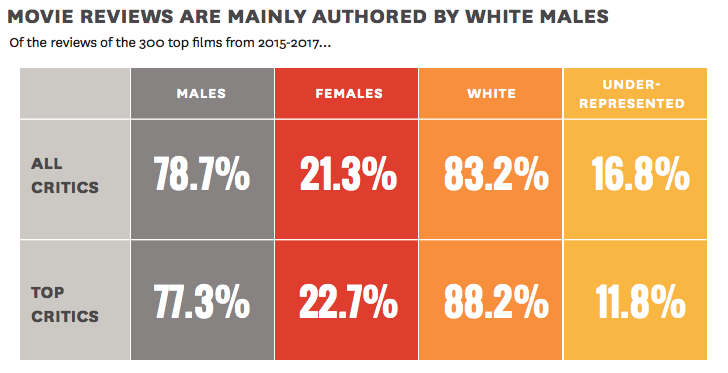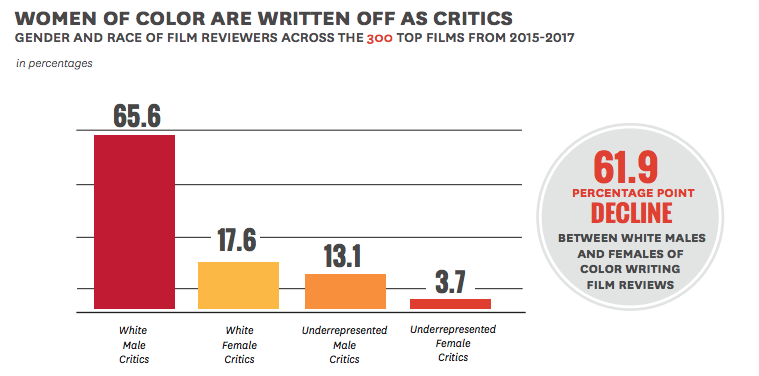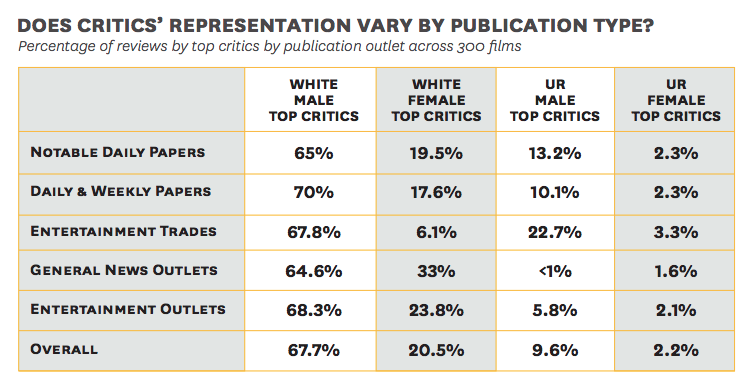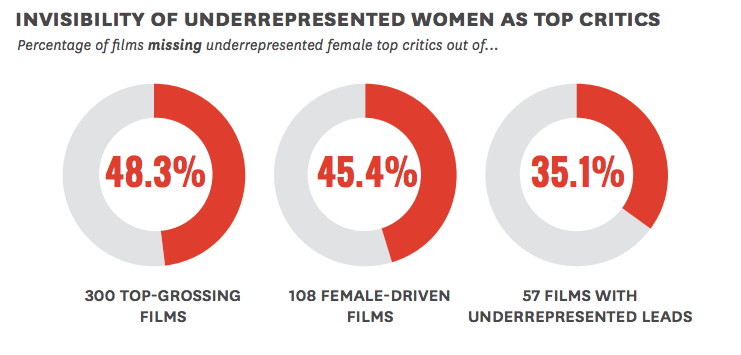A new study from Dr. Stacy L. Smith and the USC Annenberg Inclusion Initiative shows that, unfortunately, the severe underrepresentation of women critics and critics of color found in Annenberg’s recent “Critic’s Choice?” report as well as research from Dr. Martha M. Lauzen is no fluke. Those studies found that white men dominate the film criticism profession by examining reviews of the top 100 films of 2017 and films released in spring 2018, respectively. Conducted in partnership with Time’s Up, Annenberg’s latest report, “Critic’s Choice II,” examines reviews of the top 300 films from 2015-2017 and “reveals that the inequality we see among critics is not a one-time problem,” according to Smith. “These are stable patterns that demonstrate that the conversation surrounding films and their value is not an inclusive one.”

Credit: USC
Of the 59,751 reviews analyzed, just 21.3 percent were written by women and 78.7 percent by men, marking a ratio of 3.7 male reviewers for every female. POC critics penned 16.8 percent of the reviews, as compared to the 83.2 percent by white reviewers. Breaking the data down by race and gender, white men composed 65.6 percent of the reviews, while white women wrote 17.6 percent and men of color 13.1 percent. Women critics of color penned only 3.7 percent of the reviews. “Across the three years studied, there was no change over time in the representation of critics,” the study’s authors found. “The results for individuals designated as ‘Top Critics’ by Rotten Tomatoes mirror those for all critics.”

Credit: USC
“Critic’s Choice II” also found a stark gender and racial disparity among the top critics’ outlets. Top white male critics wrote 65-70 percent of film reviews at high-profile daily papers, other newspapers, trades, general news outlets, and entertainment publications. White women wrote 6.1-33 percent among these publications, men of color less than one percent to 22.7 percent, and WOC 1.6-3.3 percent.

Credit: USC
Actually — and sadly, as is typical — women of color were the most excluded. More than 48 percent of the 300 films studied did not feature one top female reviewer of color. WOC critics were again completely unrepresented among reviews of 45.4 percent of the 2015-17’s top women-driven films and 35.1 percent of the 57 films toplined by an actor of color.

Credit: USC
As Smith and her team argue, inclusion matters among film critics, and the invisibility of WOC reviewers is particularly troubling. With the disclaimer that these results should “be interpreted cautiously,” the study authors revealed that white men and women of color will score films more or less equally. “However, white male critics scored films with underrepresented female leads nearly 10 percent lower than underrepresented female critics did.” Further, on Rotten Tomatoes, WOC critics were more likely to deem films starring underrepresented women as “fresh” than their white male counterparts. Both white male and WOC critics were equally likely to rate films centered on a white man as “fresh.”
In other words, white male reviewers have a tendency to disregard films about women of color. Even taking the small sample size and the authors’ warning into consideration, the writing is on the wall: If films about people who aren’t white men are ever going to get a fair shake, they need to be seen by critics who aren’t white men.
“Dr. Stacy Smith and her team’s incredible work is at the forefront of the conversation about why it’s so vital to take action to improve representation among critics,” Oscar winner Brie Larson said of “Critic’s Choice II.” “She articulates why it’s important for the entertainment industry to embrace the diverse voices in film criticism that already exist and ensure that the critics reviewing movies represent the audience that sees them. We can all do our part to create access and opportunity for the perspectives that have long been missing from these conversations.”
Nithya Raman, exec director of Time’s Up Entertainment, added: “Time’s Up Entertainment is dedicated to removing the barriers that limit the diversity of our storytelling at every level, especially at a time when our audiences are so diverse. As pointed out through this study, when film critics are overwhelmingly white and male, films may not be given the same opportunities to succeed. We will continue to advocate to ensure that the entertainment industry proactively provides access to a much more diverse pool of critics.”
“Critic’s Choice II” points to inclusion efforts taken recently by Rotten Tomatoes and other organizations, as well as the Time’s Up critics database CRITICAL, as possible ways to bridge film criticism’s severe gender and racial gaps.
Highlights from the study are below. You can read the full report here. Smith is also presenting the findings at TIFF today, September 7.
Reviews by All Critics
- A full 78.7% of the reviews were written by men and 21.3% were by women (n=12,749) from 2015-17. No meaningful difference was observed by year. Overall, this reflects a gender ratio of 3.7 male reviews to every 1 female review.
- A full 83.2% of reviews were from white critics and only 16.8% (n=9,974) were underrepresented. These percentages did not deviate over time. The ratio of white critics to underrepresented critics is 4.96 to 1.
- The percentage of reviews written by female critics only deviated 2.5 percent between studios (high=Universal, 22.7%; low=Warner Bros., 20.2%). An even smaller window (1.6 percent difference) exists for underrepresented critics, with the high Fox (17.6%) and the low Universal (16%).
- When intersecting gender and underrepresented status, the vast majority of all reviews were written by white male critics (65.6%). White female critics (17.6%) reviewed at a slightly higher percentage than their underrepresented male peers (13.1%). Underrepresented females (3.7%) were the least likely of
the four identity groups to author reviews aggregated on Rotten Tomatoes. - The ratio of reviews written by white male critics to underrepresented female critics is 17.7 to 1.
Individual Critics
- The total sample of 59,751 reviews was penned by 2,413 individual critics. A full 67.1% of these individuals were male and 32.9% were female. Of those critics with an ascertainable race/ethnicity, 23.2% were underrepresented and 76.8% were white.
- Crossing these two measures, over half of all critics were white males (52.6%), 24.2% were white females, 14.2% were underrepresented males, and 8.9% were underrepresented females.
- On average, white male critics wrote substantially more reviews (31.3) across the sample of 300 films than did underrepresented male critics (23) or white female critics (18.3). Underrepresented female critics wrote only a third of the reviews (10.4) of their white male counterparts.
Leading Characters & All Critics
- Of the 108 female-driven films, not one featured a gender-balanced critics’ pool. Female critics comprised less than a third of the total pool across 88% of the female-driven films.
- Only two films featured female critics of color in double digits. Five percent or less of the total critics’ pool was filled with women of color across 77 female-led movies.
- Less than a third of the films with an underrepresented lead had critics’ pools with 20% or more underrepresented reviewers.
- White male and underrepresented female critics on average evaluated films with white male leads similarly (white male critics=6.1, underrepresented female critics=6.2). Their average assessment of movies with underrepresented female leads differed, however (white male critics=5.9, underrepresented female critics=6.8).
- Underrepresented female critics and white male critics did not differ in their evaluation of films with white male leads—both were nearly equally likely to denote these films as “fresh” (63.9% and 59.9%, respectively). However, when these two groups evaluated films with underrepresented female leads, women of color were more likely to rate these movies as “fresh” (81.1%) than white male critics (59.2%) were.
Reviews by Top Critics
- Of the 10,807 reviews penned by Top critics over these three years, 77.3% were composed by males and 22.7% by females. This is a gender ratio of 3.4 male Top critics to every 1 female Top critic.
- White Top critics (88.2%) wrote substantially more reviews than underrepresented Top critics (11.8%), at a ratio of 7.5 to 1.
- Among distributors, Universal (26.8%) was more likely than Paramount (19.8%), Disney (20.8%), and Warner Bros. (20.9%) to have female Top critics review their movies. For underrepresented Top critics, the difference between the highest and lowest company was only 1.8 percentage points.
- General News Outlets (34.6%) were significantly more likely to feature female Top critics than all other publications. Entertainment Trades contained the lowest percentage of reviews by female Top critics, with less than 10% of reviews across the three years authored by women. In terms of underrepresented Top critics, General News Outlets (2.3%) were significantly less likely to run reviews by these individuals compared to all other publications. Entertainment Trades were most likely (26%) to feature reviews by underrepresented Top critics.
- Women of color were the least likely to work as Top critics each year, with 2.2% of reviews written by these individuals. Underrepresented males composed 9.6% of reviews by Top critics and women wrote 20.5% of the pieces by Top critics. Fully two-thirds (67.7%) of reviews by Top critics had white male authors.
Individual Top Critics
- Of the 449 individual Top critics reviewing films from 2015 to 2017, a total of 64.1% were male and 35.9% were female. This is a ratio of 1.8 male Top critics to every 1 female Top critic.
- In terms of race/ethnicity, 85.7% were white and 14.3% were underrepresented, a ratio of 6 white Top critics to every 1 underrepresented Top critic.
- White male Top critics represented more than half (57%) of all Top critics, while white female Top critics were less than one-third (28.7%).
- Underrepresented male (7.1%) and female (7.1%) Top critics each filled less than 10% of the pool of working Top critics across the three years.
- Underrepresented male Top critics wrote the highest average number of reviews (32.3), followed by white male Top critics (28.6), white female Top critics (17.2) and underrepresented female Top critics (7.5).
Leading Character & Top Critics
- The proportion of female Top reviewers for female-driven films across the sample of 300 (n=108) were examined. Six of these films (5.5%) had a Top critics’ pool that is at or above proportional representation (50%). Ten additional films had a Top critics’ pool featuring 40% to 48.4% females.
- No female-driven films in the sample had proportional representation of women of color as Top critics (20%). Five movies featured 10% or more underrepresented female Top critics (range=10% to 12.5%).
- Of the 57 films with actors from underrepresented racial/ethnic groups at the center, none included a Top critics’ pool that reached proportional representation to the U.S. population (roughly 40%).
- A full 145 films, or 48.3%, did not have a review by an underrepresented female Top critic.
- Nearly half (45.4%) of female-driven films across the past three years — a full 49 movies — were not reviewed by an underrepresented female Top critic.
- More than one-third (35.1%) of films driven by underrepresented leads did not include one underrepresented female Top critic.







